 Mysteries
Mysteries  Mysteries
Mysteries  History
History 10 Surprising Stories About the Texas Rangers
 Humans
Humans 10 Philosophers Who Were Driven Mad by Their Own Theories
 Miscellaneous
Miscellaneous 10 Video-Game-Worthy Weapons and Armors from History
 Weird Stuff
Weird Stuff 10 Psychics Who Accurately Predicted Wartime Events
 The Arts
The Arts 10 Pieces of Art Inspired by a Broken Heart
 Health
Health 10 Science Fiction-Sounding New Medical Treatments
 History
History 10 Surprising Facts About the Father of Submarine Warfare
 Space
Space Ten Astonishing New Insights into Alien Worlds
 Weird Stuff
Weird Stuff 10 Bizarre Summer Solstice Rituals Still Practiced Today
 Mysteries
Mysteries Top 10 Haunting Facts About the Ghost Ship MV Alta
 History
History 10 Surprising Stories About the Texas Rangers
 Humans
Humans 10 Philosophers Who Were Driven Mad by Their Own Theories
Who's Behind Listverse?

Jamie Frater
Head Editor
Jamie founded Listverse due to an insatiable desire to share fascinating, obscure, and bizarre facts. He has been a guest speaker on numerous national radio and television stations and is a five time published author.
More About Us Miscellaneous
Miscellaneous 10 Video-Game-Worthy Weapons and Armors from History
 Weird Stuff
Weird Stuff 10 Psychics Who Accurately Predicted Wartime Events
 The Arts
The Arts 10 Pieces of Art Inspired by a Broken Heart
 Health
Health 10 Science Fiction-Sounding New Medical Treatments
 History
History 10 Surprising Facts About the Father of Submarine Warfare
 Space
Space Ten Astonishing New Insights into Alien Worlds
 Weird Stuff
Weird Stuff 10 Bizarre Summer Solstice Rituals Still Practiced Today
10 Exotic Pets That Escaped And Multiplied In The Florida Wilderness
When a state has newspaper headlines that read, “Avoid reptiles as a holiday gift,” then you know there’s a problem. Florida has a reputation as the number-one state in the US for invasive species. Over the past decade or so, more than 260 exotic animals (that we know of) have escaped their cages and fled into the Florida wilderness. We’re not only talking about lions and tigers and bears (oh my) but also rhinos, jaguars, wolves, orangutans, and just about any exotic creature you can imagine. Many of these escaped convicts remain at large.[1] However, this list is concerned with the species that, as exotic pets set free in the wild, were able to stick around and multiply. As the wise Jeff Goldblum predicted in Jurassic Park, life will always find a way . . .
Many of us dream of having an exotic pet, like Frida Kahlo with her monkeys or Tippi Hedren’s pet lion. Well, in Florida, you don’t need any special license or certificate to own many types of exotic pets. At the University of Florida, researchers confirm that the pet trade is the main reason for the introduction of invasive species. Exotic animals often begin as innocent pets but are released or escape into the Florida wilderness, for one reason or another, where they can wreak some serious havoc. Kenneth Krysko, manager of the Florida Museum of Natural History, says, “It’s like some mad scientist has thrown these species together from all around the world and said, ‘hey, let’s put them all together and see what happens.’ ” He warns that if the trends continue, Florida may have more invasive species than native. A wildlife ecology professor at the University of Florida likened the situation to “a slow-burning fuse lit to an ecological bomb.” Meanwhile, the exotic pet industry in the US makes $15 billion annually, and people continue to buy that flashy, unique pet that sounds alluring but is severely dangerous to both them and society at large.
10 Burmese Python
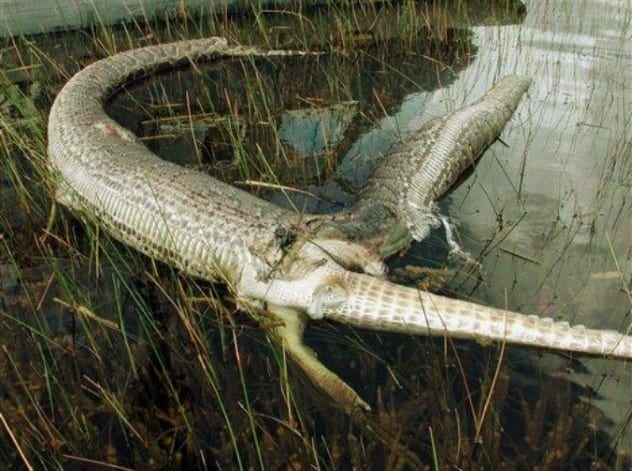
The largest Burmese python discovered in the Florida wild was 5.4 meters (18 ft) long and weighed 58 kilograms (128 lb). The man who found it in the brush, being a run-of-the-mill Floridian, grabbed it by the neck and held it up to his friends to see how big it was. The python quickly wrapped its muscled body twice around the man’s legs and then reached his waist. The man’s quick-thinking friend handed him a 23-centimeter (9 in) blade, which the soon-to-be victim used to decapitate the python.[2]
Now, it is illegal to buy a Burmese python in Florida and for good reason. People used to buy these tiny snakes, which would grow to be about 1.8 meters (6 ft) long in a year’s time. That’s either too much work or slightly horrifying, so the owners would release their beloved pets into the Everglades. This happened enough that the pythons started to breed and thrive in the wet, subtropical climate. In no time, the snakes, who can produce up to 100 hatchlings at once, became the apex predator in the region.
There was a glimmer of hope that native alligators would be able to control the rapid rise of Burmese pythons, but instead, the gators are actually being eaten themselves. In one famous case in 2005, a python tried to consume a 1.8-meter (6 ft) alligator whole, but the snake exploded in the attempt. These battles are becoming a common occurrence. Since the pythons have mostly killed all of the marsh rabbits, bobcats, and other small mammals, the Everglades now call upon hunters to eliminate as many pythons as they possibly can. The hunters are paid minimum wage by the state, plus $50 for every 1.2-meter (4 ft) snake and $25 for each additional foot. In about a year’s time, hunters have bagged 1,000 pythons.
9 Rhesus Macaque
Most people don’t know that you can ride an inner tube down the Silver River in Ocala, Florida, and likely see wild monkeys swinging from the trees as you float by. In the 1930s, the owner of a privately owned park had the harebrained idea to release an entire colony of rhesus macaques as a tourist attraction. The park staff, being the clever humans that they were, put the monkeys on an island in the Silver River for safekeeping. Surprise! They can swim. Now there are hundreds that are spreading like wildfire through Central Florida.
These feral troublemakers travel in large gangs, and they can be aggressive when they feel threatened. They have been terrorizing people in their own backyards, but that’s not even the worst part.[3] Recently, it was discovered that these macaques carry a herpes virus that spreads to humans through excrement and other bodily fluids. Having feces flung at you from a primate is horrifying enough without the fear of contracting herpes, thank you very much.
On that note, above is a hilarious video of the rhesus macaques chasing down a terrified family. Enjoy.
8 Green Iguana
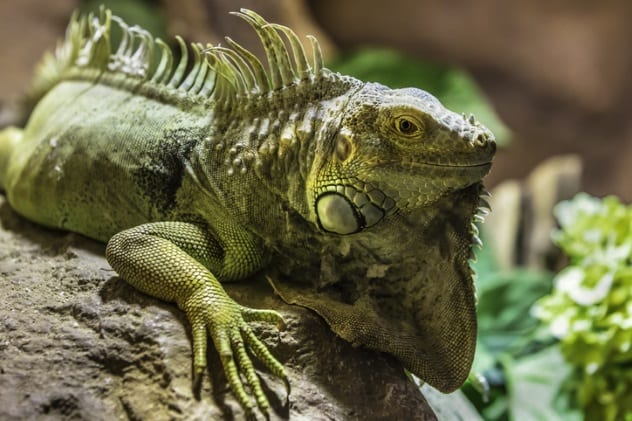
Iguanas are Florida’s most invasive species. This green menace creates mayhem in suburbia, from leaving gifts in swimming pools and gobbling up gardens to disrupting electrical grids and causing power outages. People discard iguanas as pets because they are more work than expected, as they grow up to 1.8 meters (6 ft) long and require a ton of food. During mating season, they become increasingly hostile and lash out at their owners by biting them. On top of that, they may just try to escape through the doggie door.
Sadly, Floridians have resorted to combating this pest problem they created by using blunt-force trauma. In other words, people are paid to sneak up on them in the dead of night while they sleep and bash in their skulls. Jenny Ketterlin, a wildlife biologist who works for this $63,000 project commissioned by the Florida Fish and Wildlife Conservation Commission, ensures the public that swiftly smashing their brains open is actually the most humane way to kill them.[4] Well, it’s good practice for the zombie apocalypse, I suppose.
7 Nile Monitor: Largest Lizard In Africa
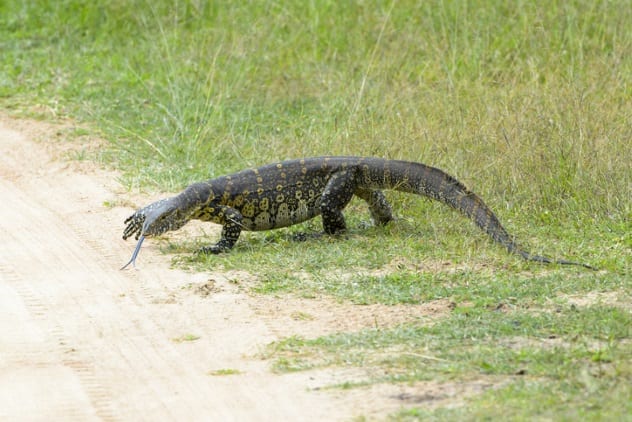
The Nile monitor is yet another escapee from the pet trade that is now calling Florida home, sweet home. Instead of soaking in the sun along the Nile Delta, where they belong, they have wormed their way through Cape Coral’s extensive canal system since the 1990s. These skilled swimmers can reach a gruesome 2.1 meters (7 ft) long. They consume whatever they can get, whether that’s a wasp nest, poisonous cane toad, or venomous rattlesnake. Like wolves, they hunt in packs. Occasionally, they pop up from the canals to make a surprise appearance in someone’s backyard. Hopefully they aren’t hungry because they’ve been known to snack on cats and dogs.
It is incredibly difficult to eradicate them, as nobody has ever found a single monitor lizard nest. There are estimated to be at least 1,000 of these giant beasts currently roaming the Florida canals, tidal creeks, and mangroves. These giant lizards may also be seen if you happen to look up, as they are expert tree-climbers, so beware.[5]
6 Capybara
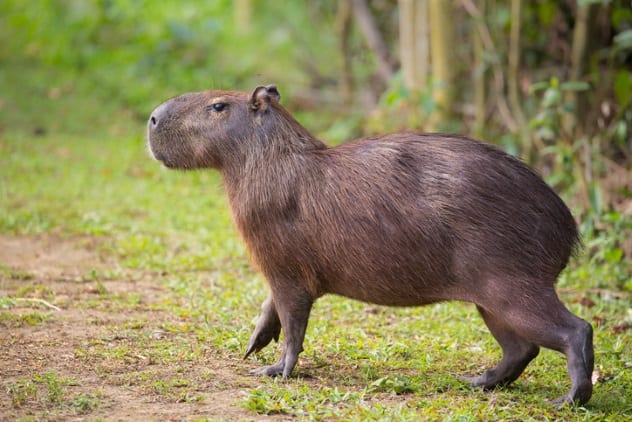
Do you know what doesn’t sound like an ideal pet? The largest rodent in the world. A capybara is basically like a 45-kilogram (100 lb) guinea pig that’s semiaquatic. It turns out, that’s not as cute as some pet owners thought it would be. Go figure! As of 2016, there were about 50 capybaras running amok in Florida. In its South American home, it has predators like the puma and jaguar, but in Florida, there are no coyotes or dogs big enough to take down a capybara.
It doesn’t help matters that they are social animals, traveling in groups through thick forest.[6] As if Florida hunters didn’t have enough game to contend with, let’s throw a giant guinea pig in the mix.
5 ‘Testicle-Eating’ Pacu Fish

The South American pacu fish has an unusual bite because of its eerie, humanlike set of teeth. They are a cousin to the flesh-eating piranha, but instead of the razor-sharp teeth of their cousins, they have teeth that are blunt like our molars. The pacu also grows to be much, much larger. They typically reach about 22.7 kilograms (50 lb) throughout South-Central Florida.
Even though the pacu is normally not an imminent threat to men’s genitalia, it did receive the moniker of “testicle-eating” fish for a good reason. According to Henrik Carl, a fish expert at the National History Museum of Denmark, “There have been incidents in other countries, such as Papua New Guinea, where some men have had their testicles bitten off. They bite because they’re hungry, and testicles sit nicely in their mouth.”[7] It’s no wonder why owners released these exotic fish! Suddenly, the bizarre allure of a human smile on a fish feels a bit more sinister.
4 Giant African Land Snails
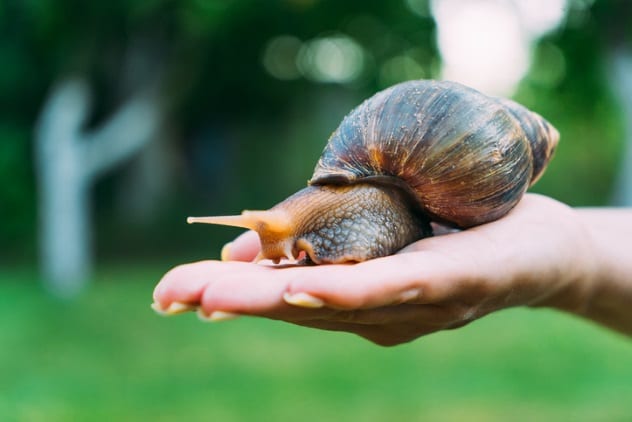
The giant African land snail is not to be confused with any meager snail of small proportions. It is, in fact, the world’s largest terrestrial mollusk. We’re talking a 20-centimeter-long (8 in) snail that’s 10 centimeters (4 in) in diameter. This destructive little creature carries a parasitic worm that burrows into humans and spreads meningitis. It consumes at least 500 types of plants and causes permanent damage to the plaster and stucco of buildings. An adult lays up to 1,200 eggs in a single year, and with no natural predators in Florida, there’s no end in sight for its infestation.
It’s a bit of a mystery why giant African land snails populate South Florida. They are illegal to import into the United States without a permit, and no permits have ever been issued. While no one is positive, it seems the pet trade is to blame for the giant snail takeover. The last known invasion was in 1966, when a young boy smuggled three snails into the country as his secret pets. When his grandma found out, she made him set them free in the garden. It cost more than $1 million to eradicate the 18,000 snails that this incident created.
Another suspicion is that the current infestation of hundreds of thousands of giant African land snails in South Florida has been the result of religious ritual. Santeria is an Afro-Caribbean religion steeped in traditions that developed from the Cuban slave trade. Some of the religious rituals put emphasis on the juice of these snails. It’s suspected that they are smuggled into the country for this purpose.[8]
3 Wild Boars
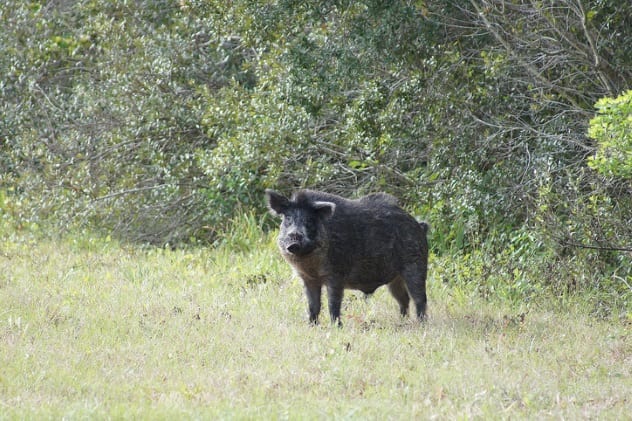
Wild boars have been roaming free throughout the Sunshine State since the 1500s, when Hernando de Soto brought them to Florida, not as a beloved pet but as a food source. Now, it has been over 500 years, and these feral pigs are nowhere near domesticated. Four million wild boars have spread across the United States, but in Florida alone, there are half a million.
They are an aggressive, tusked, 91-kilogram (200 pound) Old World swine that carry up to 24 diseases, from tuberculosis to cholera, and constantly consume farmers’ feed and even livestock. They are difficult to control, to say the least, as they are basically one giant muscle. There are also all the usual unpleasantries of invasive species, like damaging native plants and competing with native species. It basically messes up the proper chain of events that lets an ecosystem flourish.
As a result of their continued population growth, Florida hunters have trained bloodhounds to track them down at night. There are no rules that limit hunting to a certain season. There are no size, bag, or gender restrictions. Behind the white-tailed deer, the wild boar is the second most popular animal to hunt in Florida. Some inventive entrepreneurs are even flipping the boar problem on its head, making profit by serving them up on a platter and calling them prime pork.[9] Bacon anyone?
2 African Clawed Frog
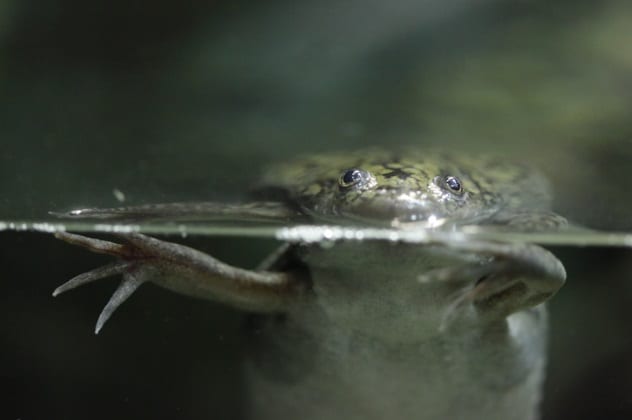
Before modern-day pregnancy tests were invented, doctors used an African clawed frog to assess the situation. The procedure involved exposing the frog to a woman’s urine, commonly via injection, and waiting for hours to see what would happen. If the frog laid eggs, it meant the woman was having a baby. This method of pregnancy detection remained popular until the 1970s, when modern pregnancy kits went on the market.
Needless to say, there was a high demand for African clawed frogs until this time. Thousands of these little critters were shipped from South Africa to labs and hospitals, not only in the US but all over the world. To supply the high demand, they were bred in captivity. They were easy to care for, so a pet trade developed around them in the 1950s and 1960s. From unwanted pets and escapees to doctors releasing them from their labs due to technology advancements, they multiplied fast. These frogs with clawed toes live for up to 15 years in the wild, and females create 27,000 eggs per reproductive cycle.[10] Their growing numbers are alarming, to say the least.
1 ‘Man-Eater’ Nile Crocodile
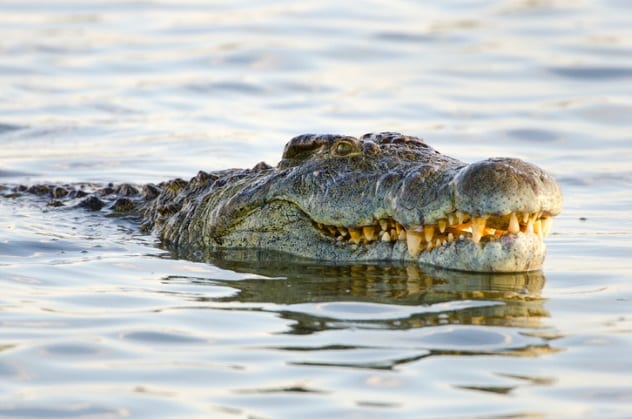
The Nile crocodile can grow over 6 meters (20 ft) long and weigh as much as a small car. They eat whatever they can get hold of, including the occasional human (hence its description of “man-eater”). From sub-Saharan Africa, they were introduced to South Florida, presumably via the pet trade, even though whoever thought that a crocodile would make a great pet clearly didn’t have a permit.
Nile crocodiles are much more dangerous than the native alligator population in Florida. In six years, American alligators and crocodiles were the cause of 33 human fatalities, but in the same time period, the Nile crocodile killed 268 people. As far as we know, they have been surviving and breeding for at least six years in the Florida swamps.[11] As if Floridians didn’t have enough monsters lurking in the water.
Read about more unusual pets on 10 Uncomfortably Odd Stories Of Exotic Pets and 10 Strangest Pets To Live In The White House.








